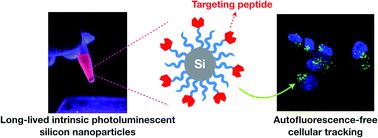当前位置:
X-MOL 学术
›
Faraday Discuss.
›
论文详情
Our official English website, www.x-mol.net, welcomes your feedback! (Note: you will need to create a separate account there.)
Luminescent silicon nanoparticles for distinctive tracking of cellular targeting and trafficking.
Faraday Discussions ( IF 3.4 ) Pub Date : 2019-12-12 , DOI: 10.1039/c9fd00124g Gi-Heon Kim 1 , Goun Lee , Myoung-Hee Kang , Minjong Kim , Yusung Jin , Sungjun Beck , Jihyun Cheon , Junyeong Sung , Jinmyoung Joo
Faraday Discussions ( IF 3.4 ) Pub Date : 2019-12-12 , DOI: 10.1039/c9fd00124g Gi-Heon Kim 1 , Goun Lee , Myoung-Hee Kang , Minjong Kim , Yusung Jin , Sungjun Beck , Jihyun Cheon , Junyeong Sung , Jinmyoung Joo
Affiliation

|
Developing therapeutic nanoparticles that actively target disease cells or tissues by exploiting the binding specificity of receptors presented on the cell surface has extensively opened up biomedical applications for drug delivery and imaging. An ideal nanoparticle for biomedical applications is required to report confirmation of relevant targeting and the ultimate fate in a physiological environment for further verification, e.g. to adapt dosage or predict response. Herein, we demonstrate tracking of silicon nanoparticles through intrinsic photoluminescence (PL) during the course of cellular targeting and uptake. Time-resolved analysis of PL characteristics in cellular microenvironments provides dynamic information on the physiological conditions where the silicon nanoparticles are exposed. In particular, the PL lifetime of the silicon nanoparticles is in the order of microseconds, which is significantly longer than the nanosecond lifetimes exhibited by fluorescent molecules naturally presented in cells, thus allowing discrimination of the nanoparticles from the cellular background autofluorescence in time-gated imaging. The PL lifetime is a physically intensive property that reports the inherent characteristics of the nanoparticles regardless of surrounding noise. Furthermore, we investigate a unique means to inform the lifespan of the biodegradable silicon nanoparticles responsive to local microenvironment in the course of endocytosis. A multivalent strategy of nanoparticles for enhanced cell targeting is also demonstrated with complementary analysis of time-resolved PL emission imaging and fluorescence correlation spectroscopy. The result presents the promising potential of the photoluminescent silicon nanoparticles toward advanced cell targeting systems that simultaneously enable tracking of cellular trafficking and tissue microenvironment monitoring.
中文翻译:

发光硅纳米粒子,用于细胞靶向和运输的独特跟踪。
通过利用存在于细胞表面的受体的结合特异性来开发可主动靶向疾病细胞或组织的治疗性纳米颗粒,为药物递送和成像广泛地开发了生物医学应用。需要生物医学应用的理想纳米颗粒来报告相关靶向的确认和生理环境中的最终命运,以进行进一步验证,例如调整剂量或预测反应。在本文中,我们展示了在细胞靶向和摄取过程中通过固有光致发光(PL)跟踪硅纳米颗粒的过程。时间分辨分析细胞微环境中的PL特性提供了有关暴露硅纳米颗粒的生理条件的动态信息。特别地,硅纳米颗粒的PL寿命约为微秒,这比细胞中天然存在的荧光分子表现出的纳秒寿命长得多,因此可以在门控成像中将纳米颗粒与细胞本底自发荧光区分开。PL寿命是一种物理强度很高的属性,可报告纳米粒子的固有特性,而与周围的噪声无关。此外,我们研究了一种独特的方法来告知内吞过程中对局部微环境有反应的可生物降解的硅纳米颗粒的寿命。时间分辨的PL发射成像和荧光相关光谱的互补分析也证明了用于增强细胞靶向性的纳米颗粒的多价策略。结果表明,光致发光硅纳米粒子具有朝着先进的细胞靶向系统发展的潜力,该系统同时能够跟踪细胞运输和组织微环境监测。时间分辨的PL发射成像和荧光相关光谱的互补分析也证明了用于增强细胞靶向性的纳米颗粒的多价策略。结果表明,光致发光硅纳米粒子具有朝着先进的细胞靶向系统发展的潜力,该系统同时能够跟踪细胞运输和组织微环境监测。时间分辨的PL发射成像和荧光相关光谱的互补分析也证明了用于增强细胞靶向性的纳米颗粒的多价策略。结果表明,光致发光硅纳米粒子具有朝着先进的细胞靶向系统发展的潜力,该系统同时能够跟踪细胞运输和组织微环境监测。
更新日期:2019-12-12
中文翻译:

发光硅纳米粒子,用于细胞靶向和运输的独特跟踪。
通过利用存在于细胞表面的受体的结合特异性来开发可主动靶向疾病细胞或组织的治疗性纳米颗粒,为药物递送和成像广泛地开发了生物医学应用。需要生物医学应用的理想纳米颗粒来报告相关靶向的确认和生理环境中的最终命运,以进行进一步验证,例如调整剂量或预测反应。在本文中,我们展示了在细胞靶向和摄取过程中通过固有光致发光(PL)跟踪硅纳米颗粒的过程。时间分辨分析细胞微环境中的PL特性提供了有关暴露硅纳米颗粒的生理条件的动态信息。特别地,硅纳米颗粒的PL寿命约为微秒,这比细胞中天然存在的荧光分子表现出的纳秒寿命长得多,因此可以在门控成像中将纳米颗粒与细胞本底自发荧光区分开。PL寿命是一种物理强度很高的属性,可报告纳米粒子的固有特性,而与周围的噪声无关。此外,我们研究了一种独特的方法来告知内吞过程中对局部微环境有反应的可生物降解的硅纳米颗粒的寿命。时间分辨的PL发射成像和荧光相关光谱的互补分析也证明了用于增强细胞靶向性的纳米颗粒的多价策略。结果表明,光致发光硅纳米粒子具有朝着先进的细胞靶向系统发展的潜力,该系统同时能够跟踪细胞运输和组织微环境监测。时间分辨的PL发射成像和荧光相关光谱的互补分析也证明了用于增强细胞靶向性的纳米颗粒的多价策略。结果表明,光致发光硅纳米粒子具有朝着先进的细胞靶向系统发展的潜力,该系统同时能够跟踪细胞运输和组织微环境监测。时间分辨的PL发射成像和荧光相关光谱的互补分析也证明了用于增强细胞靶向性的纳米颗粒的多价策略。结果表明,光致发光硅纳米粒子具有朝着先进的细胞靶向系统发展的潜力,该系统同时能够跟踪细胞运输和组织微环境监测。



























 京公网安备 11010802027423号
京公网安备 11010802027423号